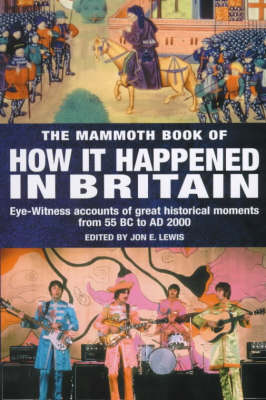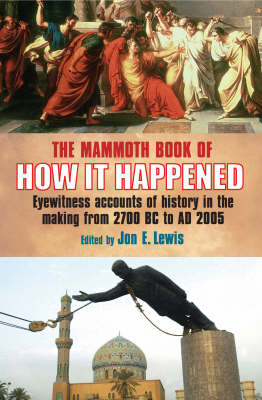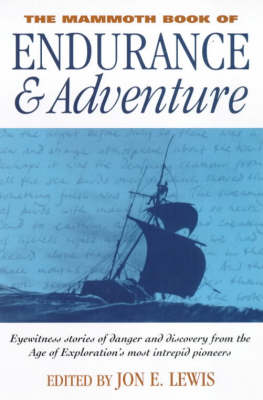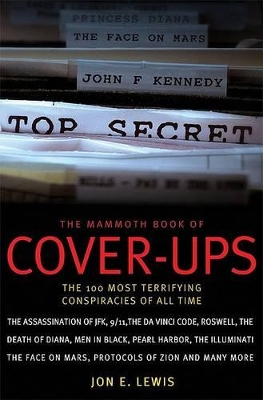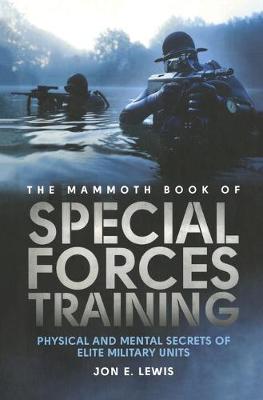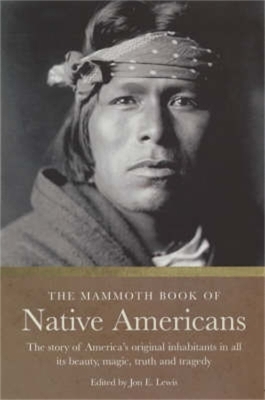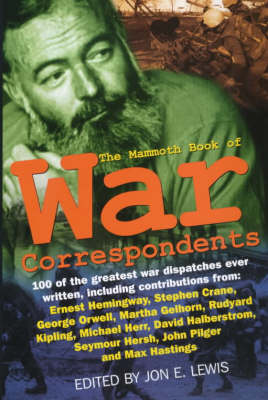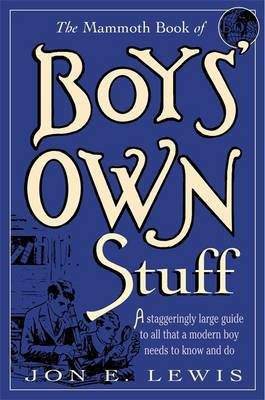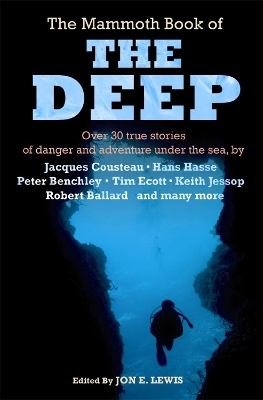Mammoth Books
10 total works
The Assassination of JFK, 9/11, the Da Vinci Code, The Death of Diana, Men in Black, Pearl Harbor, The Illuminati, Protocols of Zion,Hess, The Bilderberg Group, New World Order, ElvisFluoridization, Martin Luther King's murder, Opus Dei, The Gemstone Files, John Paul I, Dead Sea Scrolls, Lockerbie bombing, Black helicopters......
Read moreThe Assassination of JFK, 9/11, the Da Vinci Code, The Death of Diana, Men in Black, Pearl Harbor, The Illuminati, Protocols of Zion,Hess, The Bilderberg Group, New World Order, ElvisFluoridization, Martin Luther King's murder, Opus Dei, The Gemstone Files, John Paul I, Dead Sea Scrolls, Lockerbie bombing, Black helicopters...
In other words everything 'they' never wanted you to know and were afraid you might ask!
Jon E. Lewis explores the 100 most terrifying cover-ups of all time, from the invention of Jesus' divinity (pace the Da Vinci Code) to Bush's and Blair's real agenda in invading Iraq. Entertainingly written and closely documented, the book provides each cover-up with a plausibility rating.
Uncover why the Titanic sank, ponder the sinister Vatican/Mafia network that plotted the assassination of liberal John Paul, find out why NASA 'lost' its files on Mars, read why no-one enters Area 51, and consider why medical supplies were already on site at Edgware Road before the 7/7 bombs detonated.
Just because you are paranoid, it doesn't mean that they aren't out to conspire against you.
In this encyclopedic book, Lewis provides insights into the origins, training, tactics, weapons and achievements of special forces and special mission units throughout the world, focusing particularly on US and UK forces. He also looks at the codes that that bind the members of these elite units together. He...
Read moreIn this encyclopedic book, Lewis provides insights into the origins, training, tactics, weapons and achievements of special forces and special mission units throughout the world, focusing particularly on US and UK forces. He also looks at the codes that that bind the members of these elite units together. He reveals training secrets in everything from wilderness survival to hand-to-hand combat. In doing so, he draws extensively on biographies, autobiographies, training manuals, interviews and press coverage of key operations.
The elite forces covered include:
The British Army's Special Air Service (SAS), established in 1950, which has served as a model for the special forces of many countries. Its counter-terrorist wing famously took part in the hostage rescue during the siege of the Iranian Embassy in London in 1980.
The Parachute Regiment, the airborne infantry element of 16 Air Assault Brigade, which spearheads the British Army's rapid intervention capability. It is closely linked to United Kingdom Special Forces.
The US Navy's SEALS (Sea, Air, Land Teams), trained to conduct special operations in any environment, but uniquely specialised and equipped to operate from and in the sea. Together with speedboat-operating Naval Special Warfare Combatant-Craft Crewmen, they form the operational arm of the Naval Special Warfare community, the Navy component of the US Special Operations Command. Their special operations include: neutralizing enemy forces; reconnaissance; counter-terrorism (famously in the killing of Osama bin Laden); and training allies.
The US Army's Delta Force: The Special Mission Unit, 1st Special Forces Operational Detachment-Delta (1st SFOD-D), known simply as Delta Force, the Army component of Joint Special Operations Command. Its role is counter-terrorism, direct action and national intervention operations, though it has the capability to conduct many different kinds of clandestine missions, including hostage rescues and raids.
The US Army Rangers, a light infantry combat formation under the US Army Special Operation Command.
The Green Berets - motto: 'to free the oppressed' - trained in languages, culture, diplomacy, psychological warfare and disinformation.
Russia's Spetsnaz, whose crack anti-terrorist commandos ended the Moscow theatre siege, and who have a reputation for being among the world's toughest and most ruthless soldiers. Spetsnaz units saw extensive action in Afghanistan and Chechnya, often operating far behind enemy lines.
Israeli Special Forces, especially Shayetet 13 (Flotilla 13), whose motto, in common with the rest of the Israeli military, is 'Never again', a reference to the Holocaust. They are particularly adept at the specifically Israeli martial art Krav Maga, which they dub 'Jew-jitsu'.
Native Americans make up less than one per cent of the total US population but represent half the nation's languages and cultures. Here, in one grand sweep, is the full story of Native American society, culture and religion. Here is everything from the land-based spirituality of their early creation...
Read moreNative Americans make up less than one per cent of the total US population but represent half the nation's languages and cultures. Here, in one grand sweep, is the full story of Native American society, culture and religion. Here is everything from the land-based spirituality of their early creation myths and the late rise of Indian Pride, to the 88 uses to which the Sioux put the flesh and bones of the buffalo and the practice of berdache (men adopted as women).
The book offers a chronological history of America's indigenous peoples. It covers their dramatic early entry into North America, out of the now submerged continent of Beringia, then in more recent times the 'forgotten wars' of the 16th and 17th centuries, which wiped many tribes from the face of the East Coast, and finally describes to the last struggles of the Cheyenne and the Comanche. Celebrating these peoples' way of life rather than focusing narrowly on the manner of their genocide, it does not ignore uncomfortable facts of the Amerindian past - including the cannibalism believed to have been practised by some tribes and the Native Americans' part in the decimation of North America's buffalo herds.
Contents include: SAS Survival Skills; 10 Books Every Boy Should Read before Age 12; How to make invisible ink; Comic Book Superheroes, Villains and Their Inventors; A Boy Hero: Jack Travers VC; The World's 12 Decisive Battles; The Plains Indians of America; How to perform a banana kick; and much much more ...
Dive in. Death is only a breath away&
Encounter great white sharks, the stricken Kursk submarine, gold salvagers, sponge divers, giant squid, the wreck of the Titanic, Navy frogmen, and bathyscopes in record-breaking descents in The Mammoth Book of the Deep. These riveting accounts range from the Red Sea to...
Dive in. Death is only a breath away&
Encounter great white sharks, the stricken Kursk submarine, gold salvagers, sponge divers, giant squid, the wreck of the Titanic, Navy frogmen, and bathyscopes in record-breaking descents in The Mammoth Book of the Deep. These riveting accounts range from the Red Sea to the South Pacific, from the North Atlantic to the Caribbean - and include contributions by names such as Jacques Cousteau, Hans Hasse, Peter Benchley and Tim 'Neutral Buoyancy' Ecott.
Includes:
Goldfinder: Keith Jessop - salvaging the gold cargo from HMS Edinburgh Black Water: Don Camsell - an SBS training operation aboard a mini-sub goes tragically wrong off the coast of Scotland A Time to Die: Robert Moore - the operation to rescue the trapped submariners of the Kursk Discovering the Titanic: Robert Ballard - the world's foremost wreck-hunter on the world's greatest wreck Descent: William Beebe - the record breaking descent in a bathysphere off Bermuda, 1934 World Without Sun: Jacques Cousteau - the famous experiment in living for a month on the sea bed

